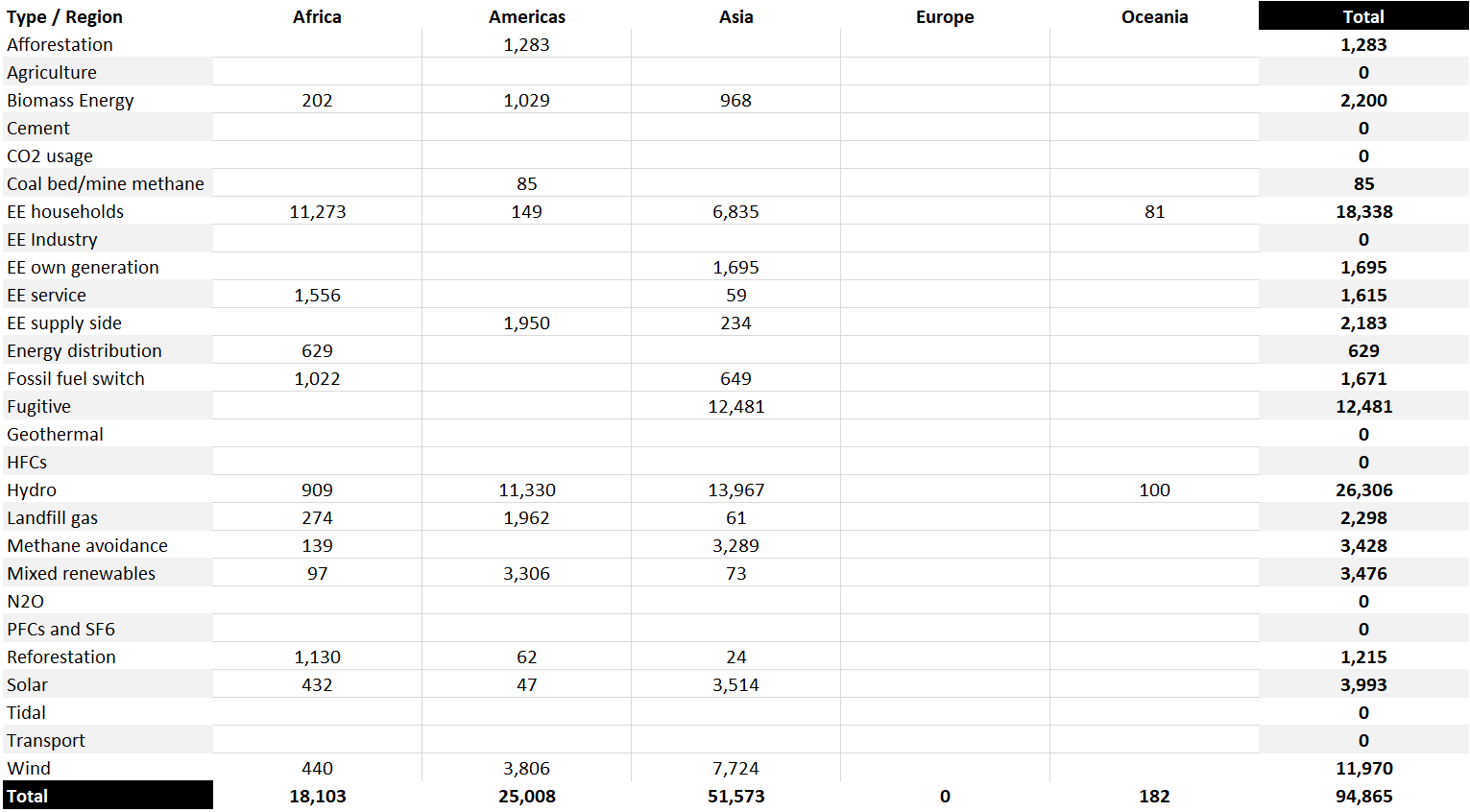CDM Pipeline
The CDM Pipeline gives an overview of the that were part of the Clean Development Mechanism, including Project Activities (PAs), Programmes of Activities (PoAs) and the corresponding Component Project Activities (CPAs). Please note: there are only very limited updates to this data – for activities transitioning to Article 6, please refer to our analysis in the Article 6 Pipeline.
CDM activities that are eligible and have requested transition to the Paris Agreement Crediting Mechanism (PACM) under Article 6.4
The deadline for submitting requests has passed. In this explainer video, we examine those activities that intend to transition using CDM methodologies and outline the next steps.
Video on the CDM Transition (08:30 minutes) – Slides: link
As of 17 April 2025, transition requests were correctly submitted for 1,388 Project Activities (PA), 119 Programmes of Activities (PoA), and (together with these PoAs) 954 Component Project Activities (CPA) (see the figure below). The first Parties approved the transition of some CDM activities. This includes 17 PA, 18 PoA, and 187 CPA hosted in Bangladesh, Bhutan, the Dominican Republic, Ghana, Myanmar, and Uganda – find more details in the Article 6 Pipeline.
Of the potential reductions of around 1.5 billion tonnes of CO2e that eligible activities could generate after transition while using CDM methodologies, this could amount to more than 900 million tonnes (60%).
For more details (such as submissions by host countries, regions, and activity types) refer to the sheet Analysis | PACM in the Article 6 Pipeline.
In addition to detailed info on each of the activities, the focus of the analysis in the CDM Pipeline is: 1) which and how many CDM activities can transition to the new Article 6.4 mechanism without applying new methodologies and 2) which and how many Certified Emission Reductions (CERs) issued under the CDM until the end of 2020 can be used to fulfil Nationally Determined Contributions (NDCs) under the Paris Agreement.
- Article 6 eligible: registered or provisional PAs, PoAs and CPAs eligible for transition to the Article 6.4 mechanism of the Paris Agreement. The criterion is: crediting period active as of 1 January 2021.
- First NDC eligible: registered PAs and PoAs with certified emission reductions (CERs) eligible for compliance with first or first updated NDCs (most of which end by 2030). The criterion is: registered on or after 1 January 2013.
For more information, a comprehensive FAQ by the UNFCCC Secretariat gives an accessible overview.
The graphs and tables below give an overview the CDM’s potential impact on arrangements under the Paris Agreement (i.e. NDCs and Article 6). For further analysis, the Excel database is freely available and the tables in the Analysis sheet can be easily adapted to the user’s needs.
Analysis of the eligibility for Article 6 transition and CER use towards countries’ first NDCs.
While there are significantly more registered Project Activities (7,892) than Programmes of Activities (365) and their associated Component Project Activities (2,871), the respective shares of how many of those are eligible for transitioning to Article 6 are similar (between 42 and 46%).
The share of PoAs eligible for using CERs for the first NDC (38%) is higher than the corresponding share of PAs (9%), because PoAs generally have later registration dates.
Table 1. Number of PAs, PoAs and CPAs (as of 2 January 2024)

Notes:
- This is a theoretical exercise to estimate the projects that are eligible for the Article 6.4 mechanism. It represents the potential (maximum) number of PAs and PoAs (as of 2 January 2024). The same applies for the activities that are eligible for issuing CERs that can be used towards the first NDC.
- For PAs, the deadline for submitting a renewal request has expired. Therefore, there will be no additional registered CDM project activities that will qualify for transition to Article 6.4 mechanism (PAs that were registered at the beginning of 2021 but de-registered since then are now also included).
- The actual numbers of PAs, PoAs and CPAs that will transition to Article 6.4 remain uncertain.
- The deadline for project participants to submit a request for the transition was 31 December 2023 – though some re-submissions are possible, this is now largely fixed (see analysis in the A6 Pipeline).
- The deadline for the host country to approve the request is 31 December 2025.
- Most countries have not yet published criteria indicating which requests they would approve.
- Host Parties may decide to approve eligible CDM projects to transition to the Article 6.4 mechanism (for issuances after 2020), to use CERs (issued between 2013 and 2020) towards the first NDC, or none of the options.
- CERs that can be used towards first NDC fulfilment do not require Corresponding Adjustment. However, Article 6 credits when traded internationally for NDC fulfilment do.
Table 2. Issuances from PAs and PoAs that are eligible for fulfilling first NDCs (during 2013 – 2020) in thousand CERs 
Monthly News on the CDM Pipeline:
The CDM pipeline contains the following updates as of April 17, compared to the last version (March 11):
- New issuances: 0.5 million CERs (none of which NDC-eligible)
- New voluntary cancellations: 1.6 million CERs